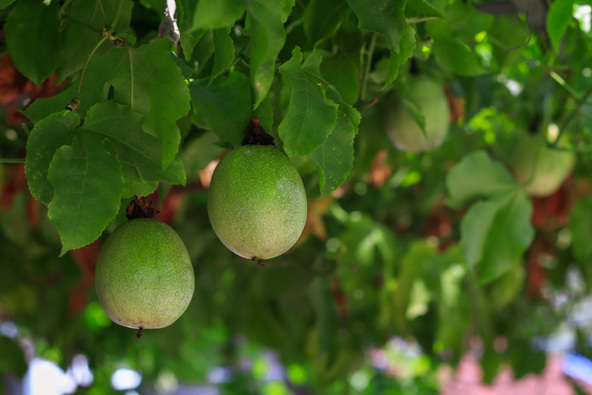You started it, Jack! Last week you mentioned that dreaded word: Passionfruit vine.
It’s not that I don’t like passionfruit – I love them.
But after many, many years of trying to grow these vines I have to confess to gangrene thumbs.
Here are some of the conditions and growing tips that I have collected over the past 45 years in Aotearoa – stuff from growers and producers of the vines, so… Grab what you like of these notes:
They need exceptional drainage and full sun.
I have always strived to provide these conditions.
Open, free-draining soils: If you have clay or such heavy soils with tiny particles that clog-up the watering, the ground needs to be raised or drainage improved.
To improve drainage, a large hole can be dug out and drainage gravel and pumice incorporated with good topsoil before back-filling the hole.
Of course, if you simply dig a large hole with the best gravel you are literally constructing an enormous sink, with the plug-hole still in it. So it pays to literally create some kind of pipe or system that takes the excess water away.
If this is all too much work you can plant the passionfruit vine in a large pot with good quality Tub-Mix (Growing mix) and drainage holes in the bottom. Make sure the pot will be slightly raised above the ground so the water can actually leave the bottom of the pot through the holes.
Do not forget to feed and water the plant; plants in large pots can dry out quite quickly.
Instead of a large pot with a good growing mix, you can always build a “raised garden bed”, say 40 cm higher than your current soil level. Once again: make sure the water can drain away effortlessly
Give the passionfruit roots ample space to establish in the raised garden bed or in the large pot. Do not over-water these roots but – on the other hand – don’t let them dry out too much.
In terms of “full sun”: I think that it might be an idea to face the plant a bit more “North-East”, rather than “North-West” (The mid-day to afternoon sun tends to be quite a bit hotter than the morning sun!)
Passionfruit is not keen on harsh winters – it hates the cold winds and frosts as these will stress the plant; couple that with wet, rainy winters days and you can see how these factors will knock the plant around. It also shows you how important good drainage is in winter!
Passionfruit are rapid growers and consequently benefit from 2 to 3 applications of a general slow release fertiliser during the spring and summer growing period. Nitrogen makes lots of new leaves.
If you have a young plant don’t prune them fiercely as they set fruit on the new growth – keep your new growth to actually get that fruit. Once the vine is well-established, you can prune it a bit more heavily, but remember to keep plenty new growth on that vine – get rid of diseased parts of the plant.
Best time to prune is right now, when warmth comes back to your garden and frosts are no longer an issue.
I hear from experts that passionfruit doesn’t last much longer than 5 or 6 years, so plant the next generation before your plant kicks the bucket…
I planted mine every year and got totally sick of it.
Take your Radio, Podcasts and Music with you










